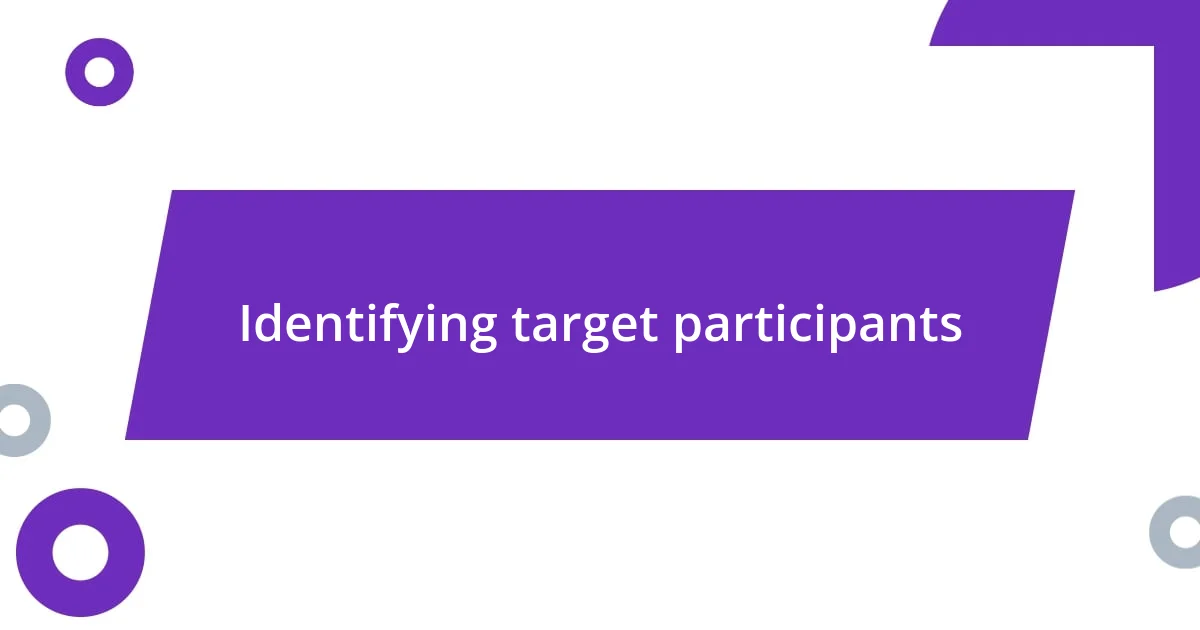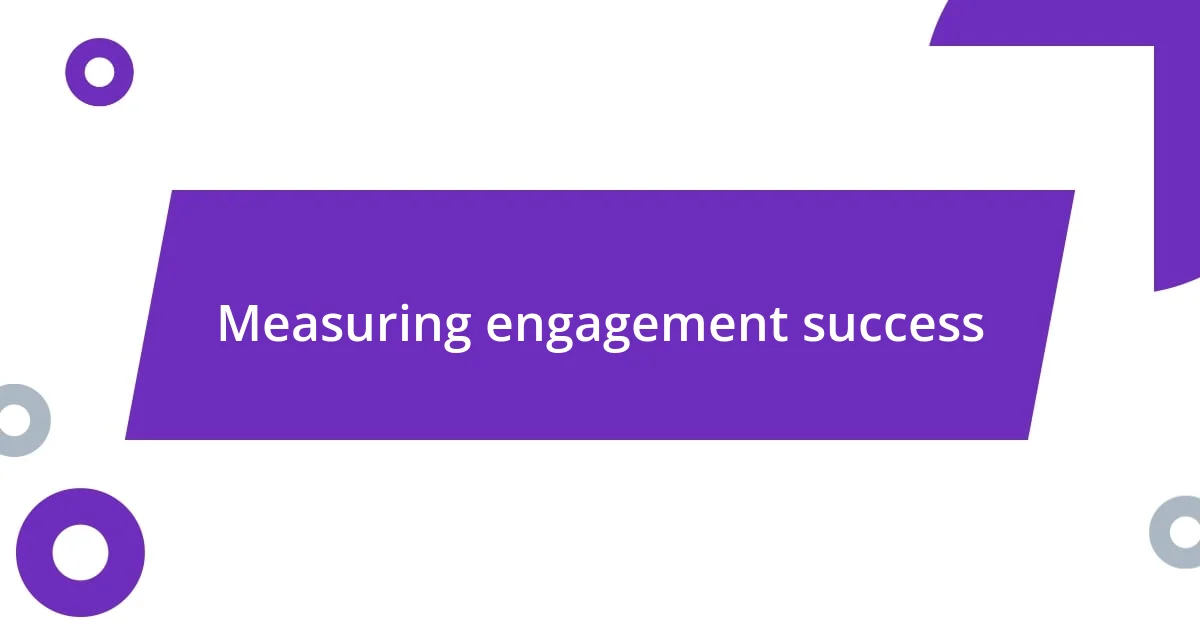Key takeaways:
- Genuine participant engagement stems from emotional connection and creating an environment where participants feel valued and heard.
- Identifying and targeting the right participants enhances engagement, as tailored approaches resonate more deeply with their interests and backgrounds.
- Interactive activities and leveraging technology transform passive audiences into active contributors, fostering collaboration and a sense of community.

Understanding participant engagement
Understanding participant engagement is about more than just getting people to show up; it’s about creating an experience that resonates with them on an emotional level. I remember a workshop I led where I noticed participants seemed hesitant to interact at first. It struck me that if I wanted them to engage, I needed to connect with their feelings and not just present facts.
When I took the time to ask personal questions like, “What brought you here today?” the atmosphere shifted dramatically. Suddenly, the room buzzed with energy, as people shared their stories and experiences. This taught me that genuine engagement springs from creating a space where participants feel valued and heard, not just as part of the audience but as integral contributors to the experience.
Have you ever considered why some discussions seem to inspire and others fall flat? From my experience, the difference often lies in the level of connection established before delving into deeper topics. Engaging participants is about inviting them into a conversation rather than delivering a lecture; it’s a two-way street where everyone’s input holds significance.

Identifying target participants
Identifying target participants is crucial for effective engagement. In my experience, knowing who you want to engage with allows you to tailor your content and approach to resonate more deeply with them. One time, I conducted a focus group for a product launch, and by carefully selecting participants who represented our key demographics, we uncovered insights that shaped the final product and marketing strategy. It was enlightening to see how the right mix of voices could elevate the discussion.
It’s not enough just to gather anyone interested; targeting your audience means considering their interests, backgrounds, and motivations. When I worked on a community project, I created personas of potential participants based on surveys and interviews. This meant that when I approached potential participants, I could speak directly to their experiences and concerns, which encouraged them to participate actively. The difference was palpable; they felt like the project was designed for them, leading to richer interactions.
I often recommend creating a clear profile of your ideal participants, including demographics like age, profession, and interests. This not only streamlines recruitment efforts but also enhances engagement once they are involved. For example, I remember organizing a webinar where we had a mix of professionals. By segmenting them based on their expertise, we could direct questions that were relevant to each group. This targeted approach turned a typical session into a dynamic discussion, ultimately making everyone feel included and valued.
| Criteria | Example Considerations |
|---|---|
| Demographics | Age, gender, education level |
| Interests | Hobbies, profession, engagement level |
| Motivations | Goals for participation, values |

Designing engaging content strategies
Designing engaging content strategies requires a delicate balance between creativity and clarity. I recall a time when I approached a project with a rigid plan, only to discover that participants thrived on flexibility. By allowing space for spontaneous input, I noticed unexpected ideas flourish, enhancing the overall engagement. It’s crucial to remain open to participants’ needs and interests, enabling the content to evolve organically.
Here are some effective strategies I’ve found helpful for creating engaging content:
- Interactivity: Incorporate polls and quizzes to encourage direct participation.
- Storytelling: Use narratives that resonate with your audience’s experiences, fostering emotional connections.
- Visuals: Include images and videos to break up text and maintain interest.
- Feedback Loops: Encourage questions and reflections throughout the session to keep the dialogue flowing.
- Purpose-Driven Content: Tailor your content to align with participants’ goals, creating relevance and value.
Every strategy I implement is rooted in an understanding that engagement is not a one-size-fits-all approach; it’s about forming a partnership with participants. I’ve learned that sometimes the simplest dialogue can lead to the most profound insights, creating a rich, lively atmosphere where everyone feels they play an essential role.

Utilizing interactive activities
Utilizing interactive activities brings a whole new layer to participant engagement. I remember when I introduced a live brainstorming session during a workshop. Instead of merely presenting ideas, I invited the participants to break into small groups and generate their own concepts. The energy in the room shifted instantly; laughter and discussions bubbled up, revealing insights that I wouldn’t have gathered through traditional methods. It was a reminder that interactivity allows voices to emerge and fosters a true sense of collaboration.
Incorporating gamification into my sessions has also been a game changer. By transforming mundane information into playful challenges, I observed how quickly participants became involved. During a training session, I divided the group into teams and turned learning objectives into a friendly competition. The enthusiasm was palpable as they raced against the clock to answer questions. Who knew that a little competition could turn a passive audience into eager participants? It’s experiences like these that show the potency of interactive activities.
Furthermore, I’ve learned to leverage technology to create a more immersive experience, such as using virtual platforms for live polls or Q&A sessions. During one online event, I incorporated real-time feedback through an interactive app. Participants could submit their thoughts and vote on ideas instantly. I was amazed at the depth of engagement this sparked; everyone felt empowered to contribute, and the conversations that followed were richer than I anticipated. It’s fascinating how just a few interactive tools can transform the participant experience, making everyone feel that their perspective truly matters.

Leveraging technology for engagement
When I think about leveraging technology for engagement, one standout experience comes to mind. During a recent workshop, I used a platform that allowed participants to create their own virtual avatars. This little touch transformed the atmosphere; suddenly, everyone felt more connected as they expressed their creativity. It made me wonder, how often do we underestimate the impact of visual representation in fostering engagement? In that instance, technology became a bridge, linking the participants not just to the content, but to each other.
Integrating social media tools into my sessions has also shifted the way I engage participants. I remember a time when I encouraged participants to tweet their thoughts using a dedicated hashtag. The immediacy of the feedback was thrilling. It was as if we were all part of a live conversation, not just within the room, but on a broader platform. This real-time interaction fueled excitement; it was compelling to see their insights resonate beyond the confines of the workshop. Have you ever tried something similar? It’s an exhilarating way to turn passive observers into active contributors, making them feel like their voices truly matter.
Moreover, I’ve witnessed how using video conferencing tools opens up new dimensions of interaction. In one session, I implemented breakout rooms, allowing smaller groups to dive deeper into discussions. I could feel the energy shift as participants collaborated in these more intimate settings. They were more willing to share their ideas without the intimidation of a larger audience. It left me pondering—how crucial is it to create spaces where participants feel safe to voice their thoughts? Technology, in this sense, isn’t just a tool; it’s a facilitator of genuine connection and collaboration.

Collecting feedback for improvement
Collecting feedback is a vital step that often reveals areas for improvement I hadn’t considered. During a recent event, I handed out anonymous post-session surveys. The honesty in participants’ comments was eye-opening—some highlighted aspects I thought were effectively engaging, while others gave me insights about pacing and content clarity that I couldn’t have gauged otherwise. It struck me just how essential it is to create a safe space for honest feedback; without it, I might have missed opportunities to enhance future sessions.
I remember implementing a quick round of live feedback using sticky notes on a board. Participants wrote down their thoughts and reactions in real-time. Seeing the colorful notes fill the board was exhilarating—a tangible reflection of the collective sentiment. This method not only allowed for quick adjustments during the session but also fostered an interactive environment where everyone felt their input was valued. Have you ever seen that kind of immediate response? It’s empowering for both the facilitator and the participants, creating a sense of shared ownership in the learning experience.
After a workshop, I often make it a point to follow up with participants over email. This personal touch encourages deeper conversation and often prompts more detailed thoughts than they might have offered on the spot. I cherish these exchanges; they often lead to unexpected discussions that help shape future workshops. When participants realize their voices continue to matter beyond the event, it strengthens their connection to the process. Isn’t it fascinating how feedback can evolve into an ongoing dialogue that enhances not only content but also community?

Measuring engagement success
Measuring engagement success goes beyond simple attendance numbers; it’s about genuinely understanding how participants connect with the content. During one of my sessions, I utilized a polling tool to ask real-time questions about their comprehension and interest levels. Seeing the responses instantly populate on-screen created a buzz in the room. It made me realize just how impactful instant feedback can be—did I strike a chord with them, or was I missing the mark? This simple interaction provided instant insights into the effectiveness of my presentation.
I’ve found that qualitative measures can be just as telling. After a workshop, I encouraged participants to share their “aha” moments with me through a brief chat. The excitement in their eyes as they recounted breakthroughs was unforgettable. I often think back to those discussions—what did they connect with most? This type of engagement isn’t just about data; it’s about those precious moments of connection that indicate real learning and growth.
When reflecting on engagement metrics, I also consider the energy in the room. I once attended a long seminar and distinctly remember the palpable shift when the facilitator invited us to share stories. The shift in mood was remarkable. It was a reminder that measuring engagement success often involves looking beyond numbers; it’s about feeling the pulse of the audience. Aren’t we all drawn to moments where we can contribute our voice? That’s the kind of engagement I strive to cultivate—one that resonates long after the session ends.














